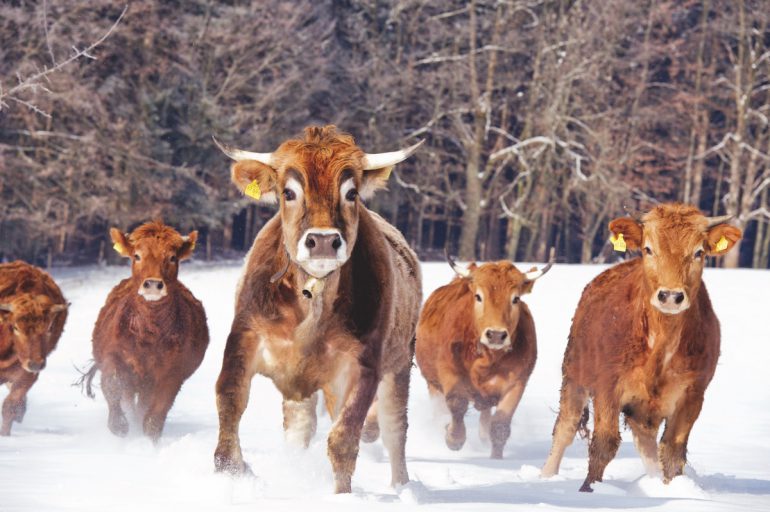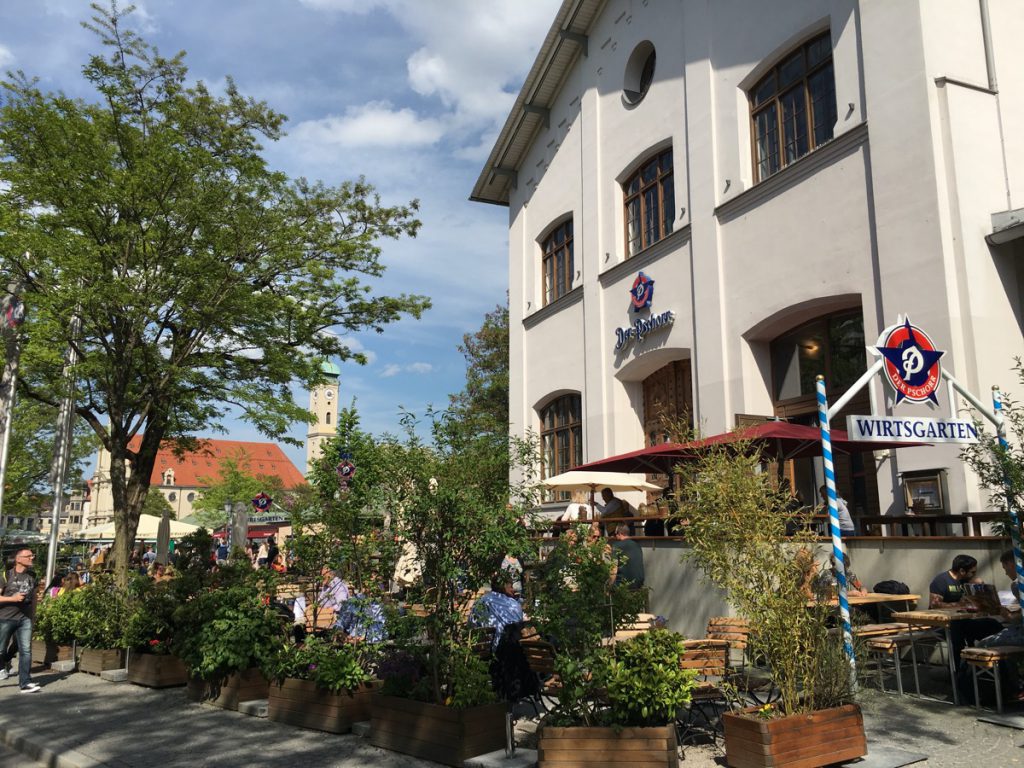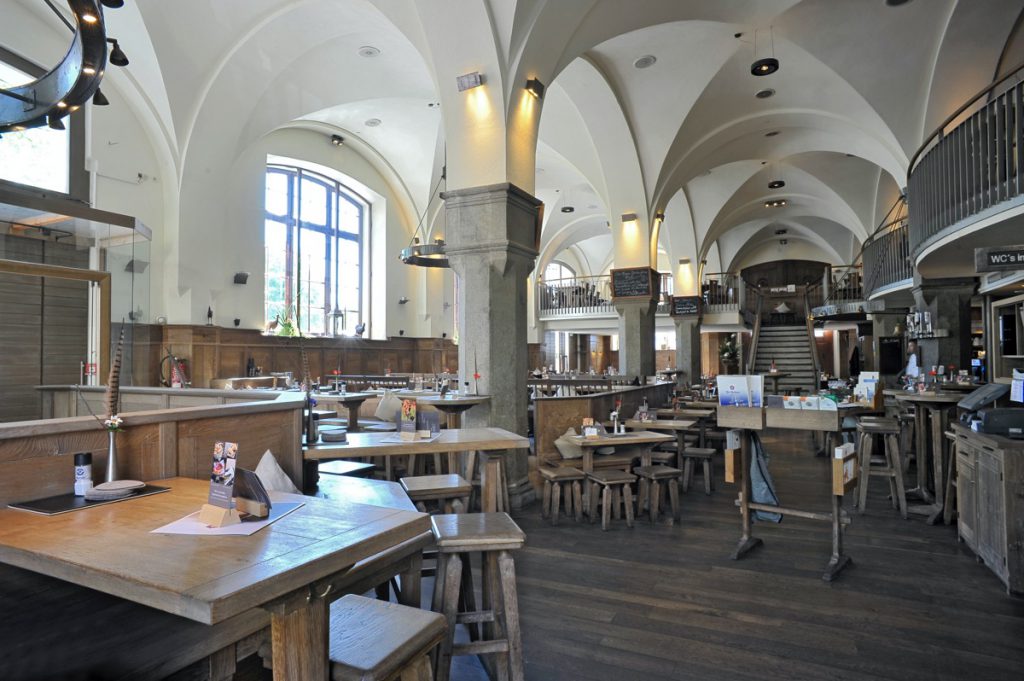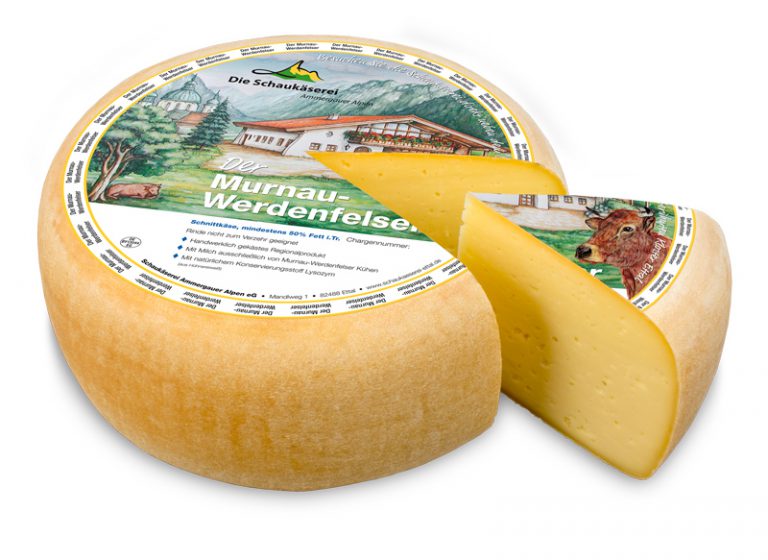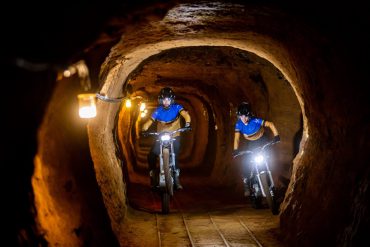The people of Upper Bavaria are said to be particularly successful at balancing modernity and down-to-earthness. And thanks to its conservative perseverance, there are – despite all the staged Bavaria folklore – still traditional customs with old costumes, genuine dialects and original folk music.
But despite the heightened awareness of what is worth preserving and conserving, a very special, living cultural asset would have been lost forever by a hair’s breadth in Bavaria, of all places: the original Bavarian cattle called Murnau-Werdenfelser Rind.
Long loved and appreciated
As in many other regions of Europe, there used to be a large number of livestock breeds in Bavaria, along with their regional varieties, the so-called „Schlägen“. 100 years ago, almost 30 breeds of cattle alone were known.
Among the most popular have always been the Murnau-Werdenfelser cattle, which in the middle of the 19th century were also called Altwerdenfelser or Oberländer. Around 1950, more than 60,000 of these frugal and vital animals were still grazing on the meadows and alpine pastures of the region around Garmisch-Partenkirchen and the green foothills of the Alps from the Murnauer Moos to Oberammergau.
The robust Murnau-Werdenfels cattle met all the demands that farmers once placed on their cattle and were kept with corresponding preference. As good feed converters, the cows of the three-use cattle gave plenty of milk despite the often meagre or sour food, the sure-footed oxen produced above-average draft performances in difficult terrain and the meat of the animals was valued for its special quality. Other reasons for their popularity were also their high age, which exceeded the other breeds in Bavaria, and their fertility. In addition, thanks to their hard claws and the high resilience of their joints, they were ideally suited for keeping on damp, even swampy, sites and on steep pastures.
Colourful ancestry
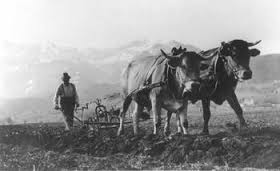
There are still no definitive findings on how exactly the original cattle breed of Upper Bavaria came into being. It is very likely that the first ancestors came via the connection of monastic farms from Stams in Tyrol to the Bavarian monasteries of Ettal and Murnau. These animals are assigned to the Oberinntal breed. Later, Grey cattle from Switzerland, various brown cattle breeds, Fleckvieh, the yellow Styrian breeds Mürztaler and Murbodner as well as the Franconian Ellinger cattle were cross-bred. More recently, attempts have been made – but with little success – to increase milk yield and enlarge the gene pool by using bulls of the French Tarentaise breed, which is not genetically related but similar in appearance.
According to its motley ancestry, the appearance of the medium-framed, single-coloured breed varies considerably. Thus, the cows show shades of red, also colours from light to dark yellow, yellow-brown to dark red-brown. Some animals wear dark, sometimes black face masks. The bulls are generally darker in colour. Their colour palette ranges from deep red to blackish brown.
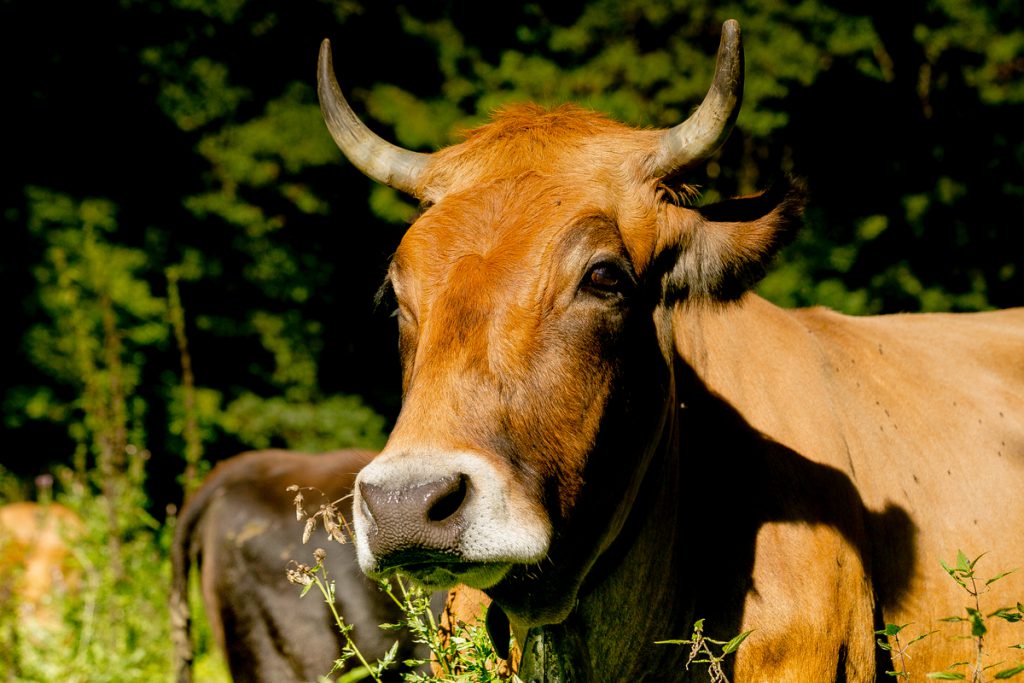
A red mop of the forehead occurs especially in the semi yellow and red-black-brown specimens. Along the back runs a light stripe, the so-called eel line. The nose leather, the claws, the hairs of the tail puff, the eyelids and the tongue are always pigmented dark grey to black. At the base the horns are whitish-yellow, in the upper third black. The black flot mouth and the dark eyelids are edged white to light yellow („Mehlmaul“).
Decline and Renaissance
There are several factors that contributed to the rapid collapse of the herds from the middle of the 19th century onwards, so much so that at times purebred animals were only kept on two farms. In 2005, only 113 herdbook cows participated in the milk performance test. The breed was thus on the verge of extinction.
A major reason for their dramatic decline was the rapidly advancing mechanisation of agriculture, as a result of which tractors replaced the powerful MW draught oxen. Until then, the breeding and sale of oxen was one of the most important sources of income for many farmers. At that time, the best bulls in particular were castrated far too quickly to satisfy the demand for working animals and thus failed as sires. As with other three-use breeds, “Verochsung” thus prevented milk and meat performance from being increased through targeted breeding measures.
When in the middle of the 20th century, with the increasing focus on milk or meat production, the planned breeding of specialised high-performance breeds such as brown or spotted cattle began, the Bavarian original cattle, which had stagnated in its performance, had clearly fallen behind. In the end, farmers were even advised by officials to break up the breed by crossbreeding with Brown Swiss or to replace it with other breeds.
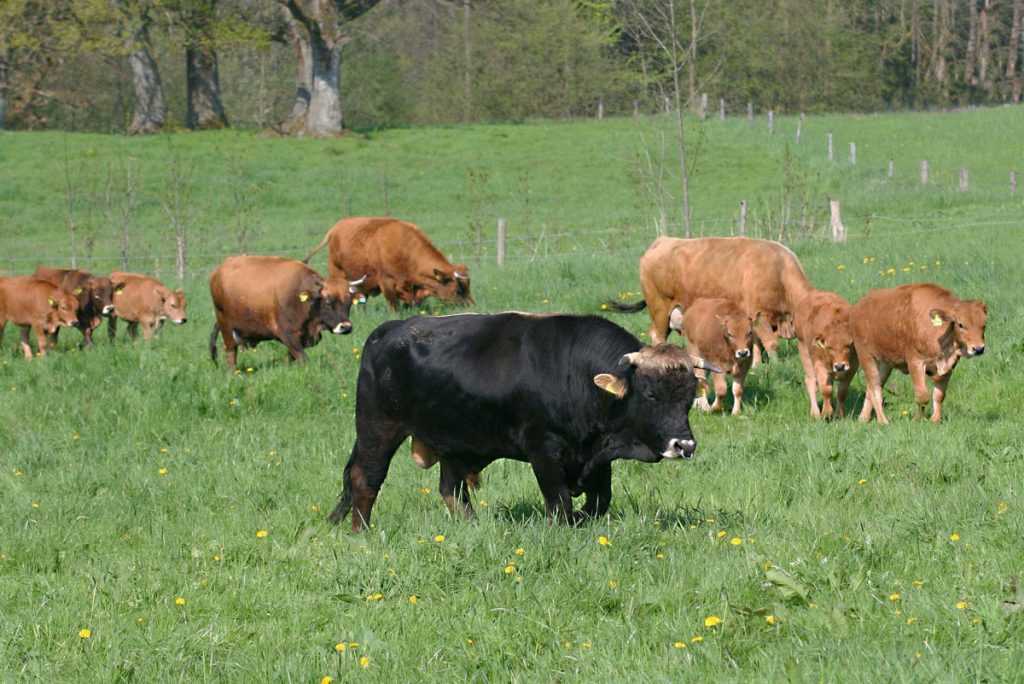
It is only thanks to the commitment of individual breeders, farmers, politicians and associations such as the GEH (Gesellschaft zur Erhaltung alter und gefährdeter Haustierrassen e. V. – Society for the Preservation of Old and Endangered Breeds of Domestic Animals) that the breed’s population has gradually recovered in recent years.
The increase of the population to about 2600 animals in the meantime is largely due to the support association founded in 2007. Its members work on a voluntary basis for the positive development of the population and support interested farmers in breeding and rearing. Through targeted marketing, they want to increase public awareness of the breed and promote its special qualities.
Ultimately, however, the final salvation of the Bavarian character cattle depends on the enlightenment, quality awareness and buying behaviour of consumers. Only if the demand for regional, high-quality products from animals from species-appropriate (pasture) husbandry – whether organic or conventional – continues to rise, will more farmers decide to keep Murnau-Werdenfelser.No matter how great the demand, it will still come to nothing if the marketing of the products is not well organised, if the potential customer does not know how to get the goods.
In the case of the Murnau-Werdenfelser, marketing and sales are fortunately professionally organised for customers and the breed. One person is largely responsible for this: Jürgen Lochbihler, at the same time Chairman of the Friends Association, Managing Director of the marketing company and landlord of the well-known restaurant “Der Pschorr” at Munich’s Viktualienmarkt.
Special qualities
Since 2005, the meat of Murnau-Werdenfels cattle has been offered as a local speciality at the „Pschorr“. In keeping with the old tradition, the entire animal is processed – from tail to nose. What used to be common practice and is now propagated as a “nose to tail” kitchen trend is not only an expression of respect for the creatures that have been killed, but also conveys new/old taste experiences at the same time. Provided the chef knows his craft, is creative and also willing to acquire knowledge about old cooking traditions. Like at the „Pschorr“, where they have even rediscovered special, long-forgotten „Schmankerl“.
For example, the menu includes the diaphragm of beef, called „crown meat“ in Bavaria and Austria. This extremely tasty piece is served grilled in many countries, in Bavaria it was usually cooked briefly. However, it is not only these special dishes that enjoy great popularity. The tender, fine-grained meat of the Murnau-Werdenfelser with its distinctive marbling is finding more and more lovers in every type of preparation. This special quality is, of course, not only due to the breed itself, but also to the species-appropriate husbandry on herb-rich pastures and the significantly slower growth compared to modern „turbo cattle“.
Hearty Bavarian ox goulash
A recipe by Franz Huber, head chef at the „Pschorr“
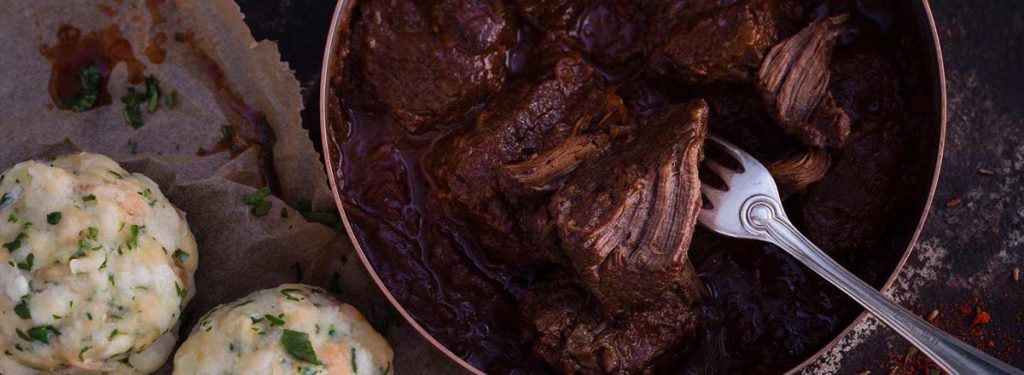
Ox goulash
800g beef goulash
6 to 8 large white onions
2 garlic cloves
4 to 5 tbsp oil for frying (e.g. rapeseed oil)
100g tomato paste
0.5l strong red wine (e.g. Bavarian Red L II)
1 untreated lemon
0.5 tsp cumin, chopped Salt, pepper
Preparation
- Cut the meat into cubes of about 5 cm. Cut the onions into fine strips and finely chop the garlic
- Heat the oil in a saucepan, add the onions and braise over a medium heat until they have turned a golden yellow colour.
- In the meantime, season the meat cubes well with salt, pepper and paprika powder.
- Add the tomato paste and garlic to the onions, then the spiced meat. Mix everything briefly and immediately deglaze with red wine (the paprika powder must not burn). Bring to the boil once and simmer at medium heat for 1.5 to 2 hours. Make sure that the meat is always covered and keep topping up the sauce with water.
- Shortly before the end of the cooking time, add some lemon zest and the caraway seeds. Season to taste with salt and pepper.
Supplements
We recommend bread dumplings and cucumber salad as a side dish.
Tip
Murnau Werdenfelser beef noble goulash is ideal for preparing this popular classic. The long-matured meat with its natural fat content turns out particularly soft and juicy when cooked.
But it is not only the meat that is appreciated by quality-conscious consumers; the milk from the Murnauer is also in a class of its own. And this in the literal sense, because scientific studies show a unique composition and great diversity of milk proteins. The „Beta-Laktoglobin W“ is found only in the „reds“, as they are sometimes called. Because of this peculiarity, their milk, despite its average fat content, is excellently suited for cheese-making. And so vegetarians can also enjoy the special quality of MW products.
Since 2016, the Ammergauer Alpen show dairy in Ettal has been serving Murnau-Werdenfelser, an artisan semi-hard cheese. Made exclusively from milk from Murnau-Werdenfelser cows.
Since 2016, the Ammergauer Alpen show dairy in Ettal has been serving Murnau-Werdenfelser, an artisan semi-hard cheese. Made exclusively from milk from Murnau-Werdenfelser cows.
In the meantime, 52 farmers from the region of origin are once again entrusted with the species-appropriate rearing of the Murnau-Werdenfels cattle, who carry out their responsible task with great care. And with a great deal of affection and respect for a Bavarian cultural asset of the highest quality.
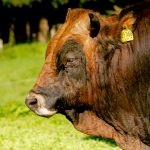
The company MuWe Fleischhandels GmbH markets products of Bavarian primeval cattle under the brand name “MURNAU WERDENFELSER, Best of Beef”. At www.murnauwerdenfelser.de you will find interesting information as well as a list of sources of supply.
Slaughtering and further processing are carried out by the Petermichl butcher’s shop in Antdorf, which is located in the breeding area: Gasthof Petermilch
The show dairy Ammergauer Alpen produces special MW cheese: Schaukäserei Ettal
Robert Höck provides interesting information about the breed in his film series about old livestock breeds under Beautiful and Rare Cattle Breeds.
Since 2005, Slowfood Germany has been carrying the Murnau-Werdenfelser cattle breed as a “passenger” of the “Ark of Taste”. More at Slow Food

